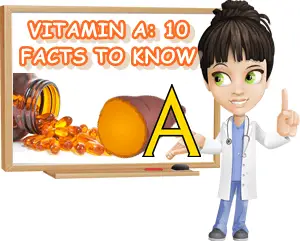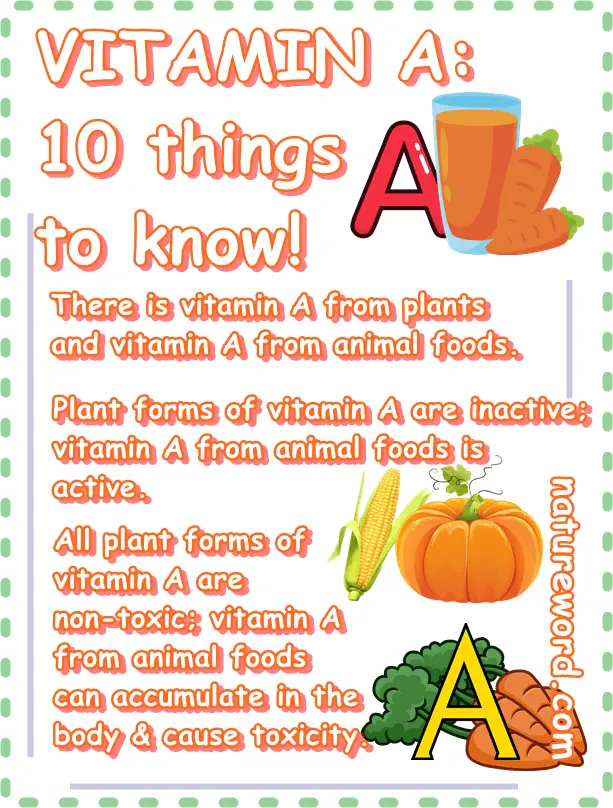Vitamin A is the first vitamin to be listed on vitamin supplements and a vitamin most people know.
At least by name. Vitamin A is best known for its benefits for eyesight and skin and also for its benefits for the immune system.
But what are other things you should know about the vitamin?
What kind of vitamin is vitamin A? Are there different types of vitamin A? What kinds of foods have vitamin A? What are the lesser known benefits and uses of vitamin A? Is there anything about vitamin A that you should absolutely know?
Read on to find out what are 10 things you might not have known about vitamin A, but definitely should!

10 Curious Facts About Vitamin A
Fact no. 1
The name ‘vitamin A’ is a common name that is used generally to refer to all the different forms of the vitamin, natural and synthetic, active and inactive.
The name vitamin A can refer to vitamin A meant for supplementation or to vitamin A used as medication.
While not technically incorrect since every constituent with vitamin A activity is vitamin A, it is nonetheless inexact to use the common name for very specific forms of the vitamin which may have highly specific uses.
Fact no. 2
The different names for vitamin A are not synonymous – each name denominates different forms/types of the vitamin with very specific uses.
For example, vitamin A in dietary supplements is almost always retinol. Beta-carotene is a previtamin A, or a precursor to vitamin A and represents a form of inactive vitamin A.
Retinal is vitamin A that can be obtained directly from food (e.g. meat), but can also be synthesized by the body from beta-carotene from plant foods.
Isotretinoin is the form of vitamin A in the popular acne medication Accutane. Isotretinoin is known to cause birth defects and other severe, sometimes permanent side effects.
Fact no. 3
Most of the different names for vitamin A actually denominate vitamers. Vitamers are different, but related forms of a vitamin.
They all perform the same functions as the title vitamin, but some are more effective and some less.
This means that the form of vitamin A you choose can make a big difference in terms of the benefits you will enjoy.

Fact no. 4
There is plant vitamin A and animal vitamin A. Vitamin A from plants occurs as pigmented red, orange and yellow antioxidants and can be found in strong orange, red and also green colored foods.
Vitamin A from plants is not actual vitamin A, but a precursor to it meaning it has to be processed by the body to end up providing all the vitamin A-specific benefits.
By comparison, vitamin A from animal foods such as liver, eggs and butter is actual vitamin A that needs no further processing to provide vitamin A-specific benefits.
Fact no. 5
Plant forms for vitamin A are previtamins or precursors to the actual vitamin and biologically inactive – that means they do not have full vitamin A activity in their current form and require some processing in the body before they exert all the vitamin A functions.
Plant vitamin A is called provitamin A or previtamin A and is converted in the body into other forms of vitamin A that are biologically active.
Fact no. 6
Animal forms of vitamin A are biologically active – they perform vitamin A functions in the body as they are, and don’t need any further processing.
Active forms of vitamin A that you can get from animal foods are better than the inactive forms of vitamin A from plant foods.
Fact no. 7
Vitamin A is a fat-soluble vitamin which means it dissolves in fat. The different forms of vitamin A have different degrees of solubility in fat meaning some dissolve better in fat than others.
Solubility in fat determines how effective a vitamin A medication will be. Vitamin A medication formulas with superior fat solubility tend to be more bioactive and produce more benefits, but also more severe side effects.
Fact no. 8
Vitamin A from animal foods can accumulate in the body and cause toxicity. Vitamin A from plant foods does not cause toxicity even when consumed in large amounts.
Vitamin A from animal foods is preformed vitamin A. And because vitamin A is fat-soluble, it gets stored in the body for longer than water-soluble vitamins such as B vitamins. If intakes of preformed vitamin A are too high, it can cause too much to accumulate in the body and lead to toxicity.
By comparison, vitamin A from plant foods is not actual vitamin A, but a type of pre-vitamin A (or pro-vitamin A).
In plants, vitamin A occurs as pigmented antioxidants and is inactive, meaning it does not yet possess full vitamin A activity. It needs to be converted into active vitamin A in the body.
But the body is the one who decides how much pre-vitamin A it converts to vitamin A based on how much vitamin A it needs at the time of ingestion. If the body needs a lot of vitamin A, it will convert more of the antioxidants; conversely, if it already has good levels of the vitamin, it will convert less of the antioxidants. This is good because it means no toxicity risks from plant vitamin A.
Fact no. 9
All vitamin A-based medicines are notorious for accumulating in the body and causing severe side effects and adverse reactions.
The longer they are taken and the higher the doses, the greater the side effects.
One of the biggest side effects for vitamin A as medication is birth defects.
Vitamin A forms such as isotretinoin in Accutane or etretinate used for the treatment of psoriasis are known to cause birth defects in babies, including defects of the Central Nervous System, defects of the skull bones and cardiovascular defects. Risks may persist for up to three years.
Fact no. 10
You can overdose on vitamin A. It’s possible to take too much vitamin A from dietary supplements and medication, and it’s possible to eat too much vitamin A.
A too high a intake of vitamin A causes the vitamin to accumulate in the body and results in toxicity symptoms.
However, for the most part, it’s unlikely if recommended dosages of various vitamin A-based medication are not exceeded and foods are consumed in reasonable amounts.
For example, dietary supplement complexes contain limited amounts of vitamin A in doses known to be safe and that do not pose risks of hypervitaminosis.
Fish liver oil, while a concentrated source of vitamin A, is very safe to use in the recommended doses. And you can also eat liver regularly, in normal food amounts, just not every day or too frequently.
For example, 100 grams of chicken liver can get the average adult 366% of all the vitamin A they need in a day.
It stands to reason that you should not eat too much of it or eat it too frequently. It’s really excesses that are dangerous.
